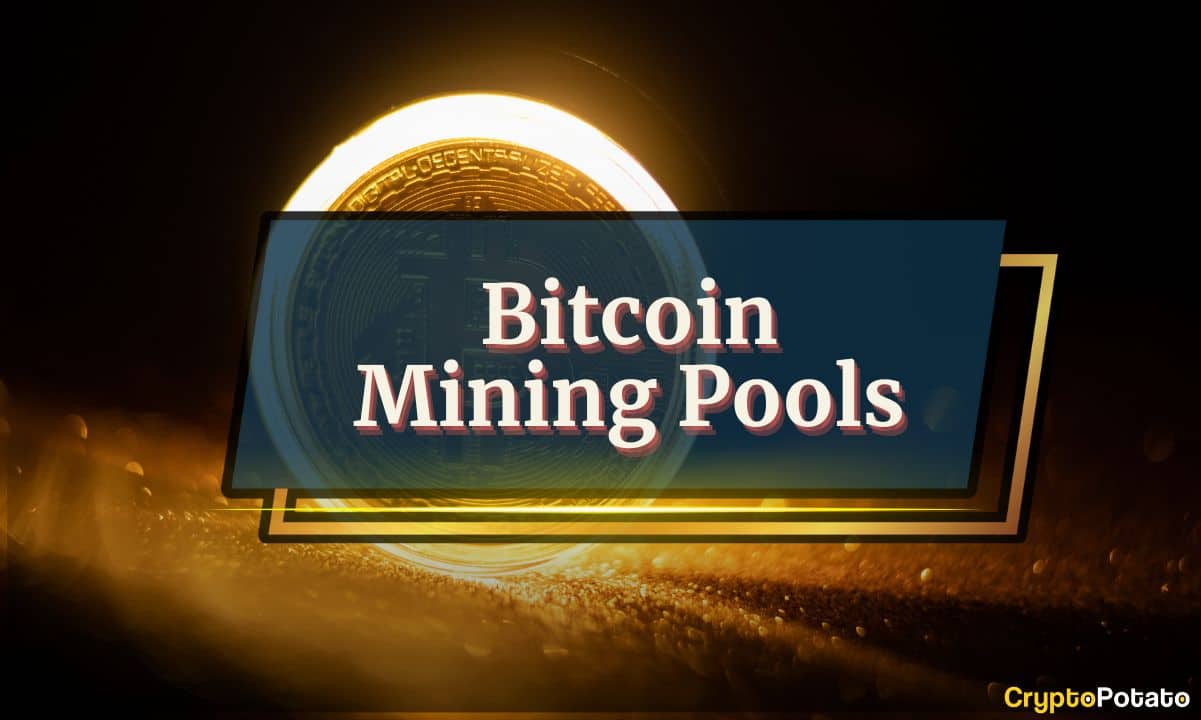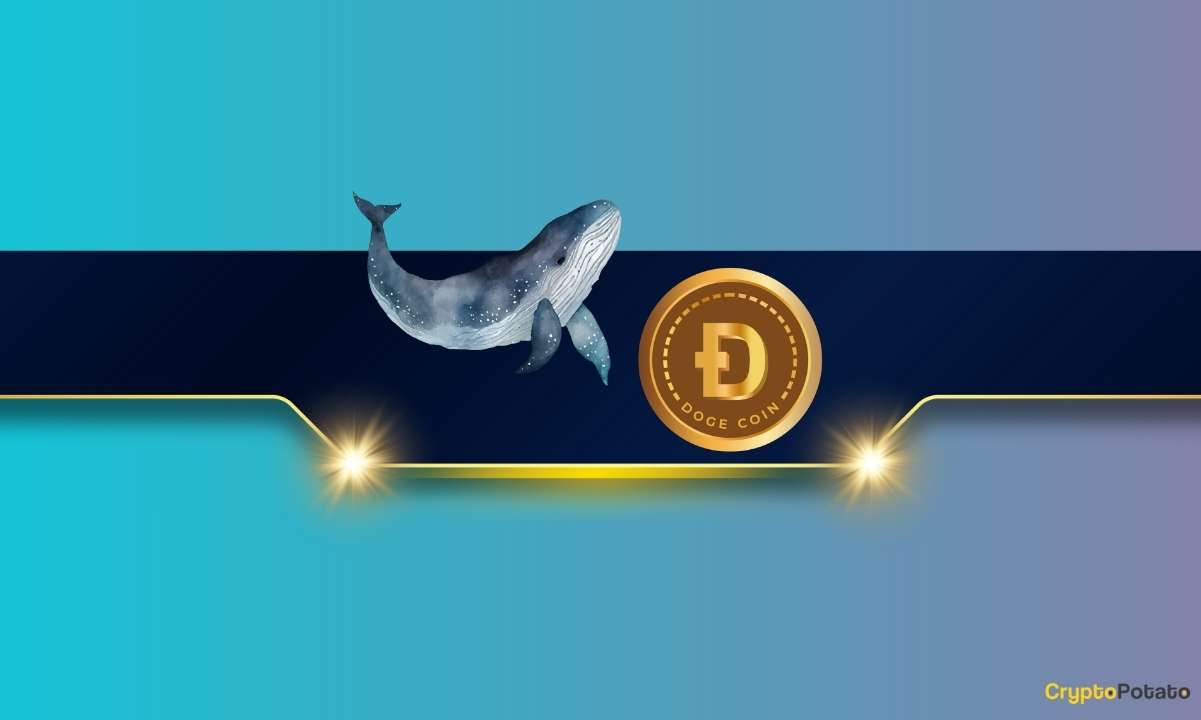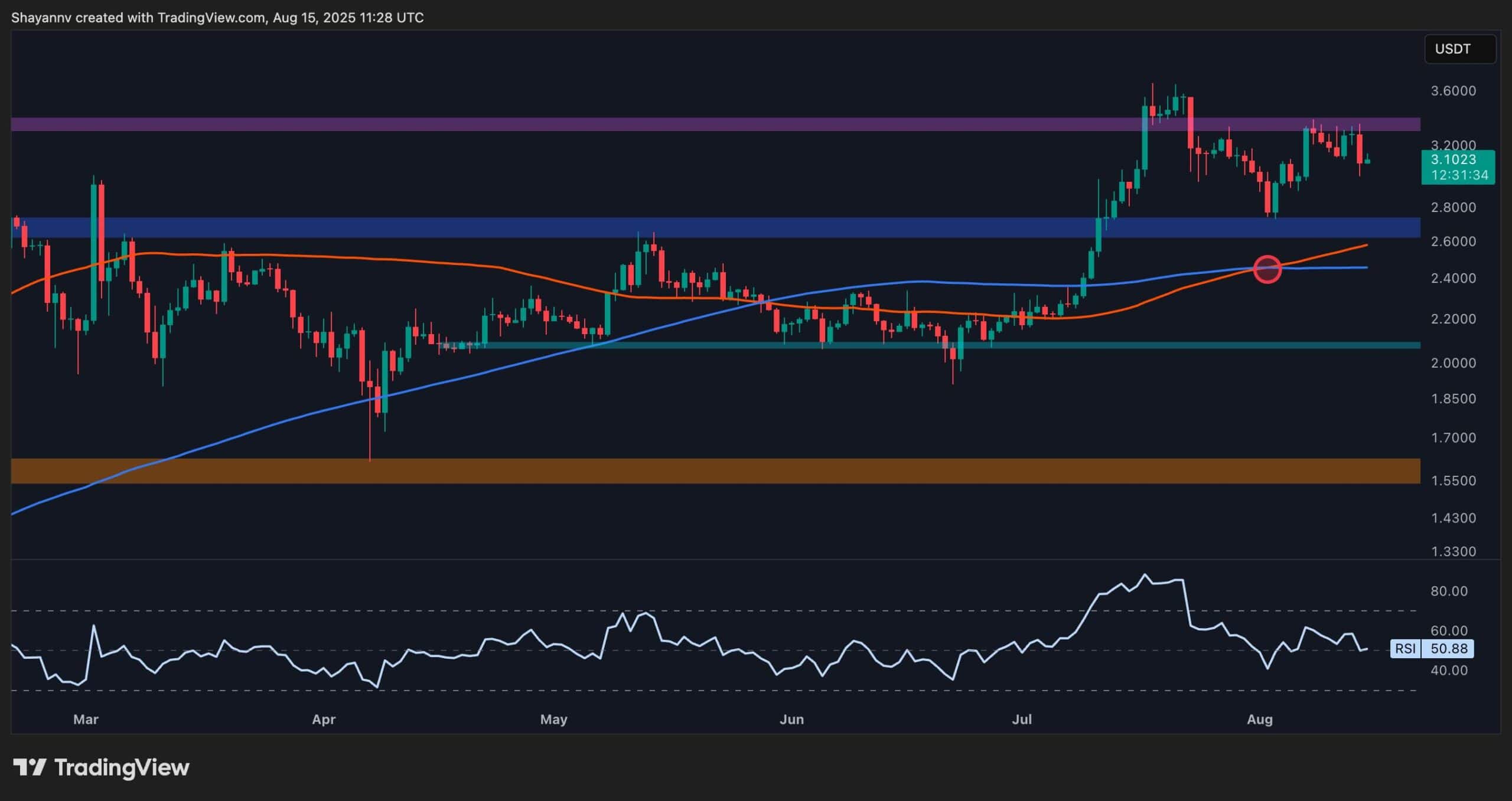Cryptocurrency
The 5 Best Bitcoin Mining Pools in 2025: Complete Guide

A Bitcoin mining pool is a group of miners who combine their computational (hash) power to boost their chances of mining new blocks. To explain more simply, the miners connect the mining hardware at the pool’s server rather than creating your own. Moreover, the pool rewards are distributed among participants based on how much hash power each provides.
Mining pools emerged as Bitcoin mining became more competitive and resource-intensive, making it difficult for smaller, solo miners to earn consistent rewards. Without considering the expense of energy and power supplies, the user would need considerable resources and capital to earn a consistent, lucrative reward.
Quick Navigation
Benefits of Joining a Mining Pool
- Consistency: More frequent rewards compared to solo mining.
- Accessibility: You can participate without massive hardware or electricity investments.
- Assistance: Many pools offer less-experienced miners support, tools, and guidance.
Mining pools also enhance network security by increasing the number of miners involved, maintaining decentralization, and preventing any one entity from dominating the blockchain.
It’s a tough market out there for miners, given how fierce the competition is, which is why most would opt for pool mining due to steadier returns while still contributing to the network’s security and decentralization. But, like anything in life, there are a few pros and cons to each:
Solo mining pros:
- Full control over any mined rewards.
- No fees to a pool operator.
And cons:
- Irregular rewards; potentially very long gaps between successes.
- High cost for hardware and electricity.
Pool mining pros:
- More consistent earnings due to collaborative efforts.
- Lower initial investment compared to solo mining.
And cons:
- Pool fees reduce overall profit.
- Less autonomy since the pool operator often makes decisions.
How Does Bitcoin Mining Work?
Now that the basics have been explained, it’s time to dive a bit deeper into the specifics. To explain how Bitcoin mining works, let’s use setting up and joining a BTC mining pool as an example.
Choosing a Bitcoin Miner
Most Bitcoin miners use ASIC devices, like an Antminer S19 or S9, because traditional GPUs and CPUs are no longer profitable for BTC mining. The mining rig should meet current efficiency standards to stay competitive.
Moving on, match your power supply unit (PSU) to the miner’s power draw. For instance, an Antminer S9 can consume approximately 1,375 watts, so a robust and reliable PSU is essential.
Next, set up a stable, wired Ethernet connection (recommended) to minimize downtime and ensure your rig can communicate consistently with the pool’s servers. This is because your shares (i.e., your units of work to prove your contribution to solving the cryptographic puzzle) must be submitted as quickly as possible, and wireless connections may experience interruptions due to multiple elements (physical obstacles, high latency, inconsistent bandwidth due to network congestion, etc.).
Miner Settings and Pool Navigation
Naturally, you want to plug in the miner and the PSU and connect an Ethernet cable to your local network. The next step is to use a network scanner, like Angry IP Scanner, to find your miner on your local network.
The tool will scan your network and show the IP addresses of all connected devices. Find the miner’s IP address and enter it into a web browser to open its control panel. Miners have default login details, often “root/root” username and password, but you may want to immediately change these credentials for security so no one else can access your miner.
Selecting a Bitcoin Mining Pool
New miners should research pools based on fees, payout schemes, security measures, and server geography. Some of the best Bitcoin mining pools include F2Pool, Foundry USA Pool, and Slush Pool.
Once you’ve selected a pool, you must create your worker credentials, which are basically your username and password. Your username (should be) often a combination of your pool account name and an optional “worker” identifier (e.g., account_name.worker_name), but the password can be of any value (or the one suggested by the mining pool).
Configuring the Miner
Next, check the pool’s website and go to the dashboard to check the list of Stratum addresses. This is a URL protocol that your miner will use to submit work and receive tasks. While mining pools offer a general/default Stratum URL, ideally, you want to choose the closest server geographically due to lower latency and better efficiency.
For example, in North America, it should be something like this:
stratum+tcp://btc-na.f2pool.com:3333.
In your rig’s control dashboard, go to miner configuration or settings and enter the Stratum address specific to your chosen mining pool, along with your pool username and password.
After saving, your miner will begin directing its hashing power toward the pool.
Linking a Bitcoin Wallet
Connect your Bitcoin wallet address to the pool. This can be part of your account profile on the pool’s website. Some pools allow participants to set a minimum payout threshold, controlling how often their earnings are sent to their wallets.
If you don’t have one already, check out our guide on some of the best Bitcoin wallets in 2025, from hot to cold solutions.
Starting the Mining Process
After it is configured, your miner will send shares (the units of work) to the pool, which aggregates all participants’ hashing power to find valid blocks. In return, you receive a percentage of block rewards proportional to your contribution. The more you contribute, the more you are rewarded.
You can monitor your miner’s performance either through its own interface or the pool’s website.
How Are Rewards Distributed in Bitcoin Mining Pools?
There are three types of payout models for rewards. Each approach involves specific trade-offs concerning fees, rewards, and risk:
- Pay-Per-Share (PPS): With PPS, you receive a fixed, predetermined payout for every share your mining hardware submits to the pool. The pool operator absorbs the risk of whether a block is actually found, offering you predictable and steady income.
- Full Pay-Per-Share (FPPS): FPPS builds on PPS by paying a fixed rate per share and including an estimated share of transaction fees in addition to the block reward. This method offers even more predictable earnings by smoothing out the variability of transaction fee income, but it can come with slightly higher fees since the pool operator is assuming more risk.
- Pay-Per-Last-N-Shares (PPLNS): This method pays out only when the pool finds a block, distributing rewards based on the proportion of the last N shares submitted by all miners. Your payout can fluctuate. If the pool is unlucky or you disconnect before a block is found, your earnings for that period may be low or zero. Over time, however, this method can yield higher rewards during lucky periods.
How to Choose the Proper Payout Method
Choosing a reward distribution model is as important as choosing the right pool. There are four main points to consider: risk tolerance, fees, mining goals, and dependency on operators, which can be summarized as follows:
- PPS and FPPS are good fits for those who prefer a steady income and avoid fluctuations tied to block discovery. However, PPS and FPPS pools tend to charge higher fees because they assume more risk but pay their participants regardless of block discovery.
- However, PPLNS pools offer lower fees but are much more volatile. They often have uneven payouts depending on how often the pool finds blocks. In other words, the more blocks that are found, the higher the yield.
Generally speaking, there are two reasons why a miner would choose PPs or FPPS: either they have limited resources, or they want predictable, steady income. However, those with substantial hashing power and resources often gravitate toward PPLNS because of the bigger yields. This maximizes overall earnings in times of bullish market activity but accepts some short-term uncertainty, all in exchange for the biggest rewards.
Risks of Using Bitcoin Mining Pools
When using a BTC mining pool, there are three main risks miners should be aware of.
It’s no secret that large pools can dominate the share of the Bitcoin network’s total hashrate. Such a concentration of power defeats the purpose of decentralization, as a few entities wield increased influence over transaction validation and block production.
Another risk to consider is chain and pool manipulation. Pools may commit certain unethical practices, like withholding valid blocks to gain an advantage or censoring specific transactions to compromise the network’s security and trustworthiness. Moreover, operators hold significant control over reward distribution, and those dishonest may manipulate payouts, delay rewards, or even vanish with participants’ funds (in what is known as an exit scam).
When assessing any mining pool, it’s prudent to verify its track record of uptime, the security measures in place, such as advanced Distributed Denial-of-Service (DDoS) protection, and its history of handling potential threats. In that sense, a secure and dependable pool protects your earnings and operational consistency.
A pool experiencing repeated disruptions (DDoS attacks, most often) can lead to server downtime, impacting profits. For instance, in 2020, Poolin, one of the largest Bitcoin mining pools at the time, suffered a DDoS attack in which the pool’s servers were flooded with malicious traffic. This caused downtime and a loss of revenue for participating miners.
In addition to the above, researching a pool’s reputation and transaction history is always a fundamental step before joining one.
But even so, there’s no guarantee that a reputable mining pool won’t engage in questionable behavior. For instance, F2Pool, a leading miner in terms of network hashrate, drew criticism back in 2023 when it began filtering transactions linked to addresses sanctioned by the US Office of Foreign Assets Control (OFAC). It was found that the pool excluded specific transactions from its blocks, imposing external compliance measures within what is intended to be a neutral, decentralized network.
Needless to say, this action ran counter to Bitcoin’s principle of censorship resistance, sparking community backlash. F2Pool eventually halted its filtering patch, but the point remains the same.
Best Bitcoin Mining Pools
Some of the top Bitcoin mining pools are listed below, according to their hashpower, popularity, payouts and fees, security, and key features, among other crucial considerations.
Foundry USA
Foundry USA is the largest Bitcoin pool in 2025, controlling over 30% of the network hashrate.
Key Features
- Institutional-grade services: In addition to standard pool operations, Foundry offers treasury management, BTC custody, and derivatives products, which are mostly targeted at large-scale enterprises.
- Security and compliance: Foundry has SOC 2 Type 1 and Type 2 certifications, which means strong internal controls and operations. Moreover, all members must fulfill Know Your Customer (KYC) and Anti-Money Laundering (AML) requirements before joining, which may deter miners who prefer anonymity but provides a safer environment for both retailers and mining companies.
- Transparency and reliability: Detailed fee structures, exportable data, and in-depth analytics. This allows miners to evaluate and track their performance much more efficiently.
Fees and Payment Methods
Foundry USA has a tiered structure that adjusts rates according to a miner’s quarterly average hashrate. Deductions come from the FPPS payouts, including newly minted Bitcoin, e.g., block subsidies and transaction fees. Under FPPS, miners benefit from regular and predictable payments credited daily.
Moreover, a 0.001 BTC minimum payout threshold makes Foundry approachable for smaller-scale operations, allowing frequent distributions even for those not contributing massive amounts of hash power.
Hashrate and Supported Equipment
Foundry USA is the largest mining pool, contributing roughly 277 to 280 EH/s to the Bitcoin network. This means it finds blocks quickly, providing reliable payouts for participating miners.
The pool supports various popular ASIC miners, including Antminer S19 models, WhatsMiner M50 series, and AvalonMiner rigs.
Pros and Cons
Pros explained:
- Stable FPPS payouts, which include transaction fees
- High-level security with SOC certifications and robust compliance measures
- Institutional services, providing lending, custody, and advanced financial products
- Advanced analytics and tools for miners
Cons explained:
- KYC/AML requirements, which can be off-putting for certain miners
- Holding over a third of the network hashrate means the pool has a massive influence on the Bitcoin network
AntPool
AntPool, launched by Bitmain Technologies in 2014, remains one of the most influential Bitcoin mining pools.
As of early 2025, it commands close to 19% of the network’s total hashrate, providing miners with a robust infrastructure and multiple reward structures. Although primarily focused on Bitcoin, AntPool also supports other proof-of-work cryptocurrencies.
Key Features
- Multi-currency support: In addition to Bitcoin, AntPool supports Bitcoin Cash (BCH) and Litecoin, among other popular PoW options.
- Global server: AntPool operates servers worldwide, helping reduce latency and stale shares. This network design contributes to more stable performance, regardless of a miner’s geographic location.
- Daily payouts and reliability: Once a miner’s balance reaches 0.001 BTC, earnings are sent out every 24 hours. Security measures include two-factor authentication (2FA), DDoS protection, and wallet locks, all of which safeguard user accounts.
- Tools and resources for miners: The dashboard offers real-time hashrate metrics, detailed income histories, and integrated profitability calculators. These features simplify monitoring and help users fine-tune their operations.
Fees and Payment Methods
AntPool offers three payout schemes, and they come with varying fees, influencing individual earnings:
- PPLNS: 0% fee (transaction fees not included).
- PPS+: 2.5% fee.
- FPPS: 4% fee.
Miners receive payouts once they exceed the 0.001 BTC threshold. Distributions occur daily after that balance is reached.
Hashrate and Supported Equipment
With a reported output of approximately 132.7 EH/s, AntPool contributes close to 19% of the total Bitcoin network hashrate. AntPool accepts many ASIC miners, including Bitmain’s Antminer series (S19 Pro, S19 XP), WhatsMiner (M50), and AvalonMiner devices. Although it is developed by Bitmain, other SHA-256 ASIC rigs can connect without issue.
Pros and Cons
Pros explained:
- Multiple payout models
- Zero fee for PPLNS (transaction fees not included)
- Backed by Bitmain’s longstanding mining expertise
- Global server infrastructure for reduced latency
Cons explained:
- FPPS has a higher fee (4%) compared to some alternatives
- Large share of hashrate may increase centralization concerns
- Some users find the interface less streamlined than other pools
ViaBTC
ViaBTC is one of the best crypto mining pools, with a reputation for robust infrastructure, extensive coin support, and a vast suite of resources and tools for miners.
Headquartered in China, it has become the third-largest Bitcoin mining pool globally, holding about 14% of the network’s hashrate as of early 2025. In addition to BTC, ViaBTC covers numerous other PoW cryptocurrencies.
Key Features
- Wide range of assets: ViaBTC supports over 20 crypto assets, including BTC, BCH, LTC/DOGE (merged mining), ZEC, and DASH.
- Global server: Distributed servers minimize latency and ensure stable connections for participants across different regions.
- Auto-conversion: Miners are not required to manually trade their BTC earnings as the pool can automatically convert their profits.
- Security measures: ViaBTC implements two-factor authentication (2FA), multi-level risk controls, and wallet locks for enhanced account protection.
- Advanced tools and cloud mining: The pool offers real-time performance tracking, mobile apps for on-the-go monitoring, and a cloud mining feature for those who prefer mining without owning physical equipment.
Fees and Payment Methods
ViaBTC offers PPS and PPLNS for miners, charging 4% and 2%, respectively.
Hashrate and Supported Equipment
ViaBTC contributes around 83.5 EH/s, accounting for approximately 14% of Bitcoin’s total hashrate.
Moreover, ViaBTC supports ASIC miners for Bitcoin and other SHA-256 coins and GPU rigs for altcoins such as Ethereum Classic (ETC) or Zcash (ZEC). It also offers various setup guides for mining software like PhoenixMiner or T-Rex Miner.
The default minimum threshold for payouts is 0.0001 BTC, making the pool accessible to smaller-scale participants. Miners are paid once they exceed this amount, with disbursements typically processed daily.
Pros and Cons
Pros explained:
- Supports multiple cryptocurrencies for diversification
- Different payout methods
- Low payout threshold to suit smaller miners
- Strong security features
- Auto conversion and other tools to simplify user experience
Cons explained:
- PPS fees are higher than most competitors
- Cloud mining is still considered risky as it’s often associated with market volatility
Luxor Mining Pool
Luxor Mining Pool, established in 2018, is a North American-based operation recognized for its Full Pay Per Share (FPPS) model and broad support for multiple cryptocurrencies.
Though its Bitcoin hashrate is lower than some market-leading pools, Luxor remains a strong choice for miners seeking hourly payouts, competitive fees, and extra services like Catalyst, which allows mining altcoins but receiving rewards in Bitcoin.
Key Features
- Catalyst service: Multi-coin miners can direct their hash power to coins like Zcash or Dash but opt for Bitcoin payouts, simplifying portfolio management across various networks.
- Global servers: These are spread across Asia, Europe, and the Americas to reduce latency and bolster uptime for miners worldwide.
- Advanced analytics and developer tools: Luxor’s dashboard offers detailed performance tracking, an API for custom integrations, and user-friendly resources for real-time monitoring.
- Security: The pool is certified SOC 2 Type 2, bolsters accounts with 2FA, and maintains cloud redundancy to safeguard miner data.
- Tax reporting integration: Miners can partner with Luxor’s recommended platforms to automate tax filings for cryptocurrency revenues, streamlining compliance.
Fees and Payment Methods
The pool charges a fee of 0.7% for Bitcoin, only under the FPPS system, with consistent hourly payouts based on submitted shares, including block rewards and transaction fees. For altcoins, the fee structure may vary, as some altcoins use PPS or PPLNS models (occasionally at 0% for PPLNS).
Luxor’s 0.7% fee under FPPS compares favorably against other major pools, especially those with higher percentages for full pay-per-share payouts.
Hashrate and Supported Equipment
Luxor contributes an estimated 20 EH/s to the Bitcoin network, which puts it behind some larger competitors yet keeps it influential in North America.
The pool works with leading ASIC miners:
- Bitmain Antminer (e.g., S19 Pro, S19 XP)
- WhatsMiner (e.g., M50 series)
- AvalonMiner devices
GPU mining is also supported under the Catalyst feature for certain altcoins. The minimum Bitcoin payout is 0.004 BTC.
Pros and Cons
Pros explained:
- Competitive 0.7% FPPS fee
- Hourly payouts for stable earnings
- Catalyst service converts altcoin gains into Bitcoin
- Strong security (SOC 2 Type 2, 2FA)
- Developer-friendly API for advanced analytics
Cons explained:
- Roughly 20 EH/s—smaller than major pools like Foundry USA or AntPool
- Higher payout threshold (0.004 BTC) can be less convenient for small-scale miners
- No merged mining support (cannot mine multiple coins simultaneously under a single algorithm)
F2Pool
F2Pool is among the market’s longest-running and most diverse cryptocurrency mining pools. Established in 2013, it supports over 40 digital assets, including Bitcoin, Ethereum PoW (ETHW), Litecoin (LTC), and many more.
Alongside its broad coin coverage, F2Pool offers a range of payout structures (PPS+, FPPS, and PPLNS), daily automatic distributions, and strong security features to safeguard miners’ earnings.
Key Features
- Multi-currency support: F2Pool accommodates more than 40 cryptocurrencies. It also supports different hardware for these altcoins.
- Advanced tools: F2Pool delivers in-depth statistics like real-time hashrate monitoring, revenue history, and profitability projections. It also supports cross-platform accessibility through web and mobile apps, making it straightforward for miners to track and manage their operations on the go.
- Security measures: Strong DDoS defenses and secure payout systems help minimize disruptions. The company’s reputation, built over nearly a decade, is a testament to its dependable infrastructure and prompt responses to potential threats.
Fees and Payment Methods
2FPool offers three types of payment methods, depending on the user’s need: PPS+, FPPS, and PPLNS.
F2Pool’s Bitcoin mining fees vary based on the payout model, generally ranging from 2% for PPLNS to 4% for FPPS. Although this may be slightly higher than smaller pools, many miners find the stability and reliability worthwhile. Again, it all depends on the user’s goals and needs.
Bitcoin miners can expect a minimum payout of 0.005 BTC by default, which they can adjust in their account settings to suit their preferences.
Hashrate and Supported Equipment
F2Pool provides about 10% of the total Bitcoin network hashrate in 2025, translating into roughly 81.4 EH/s. This means the pool often finds blocks relatively quickly. Moreover, most modern ASIC devices, like the Antminer S19 series, are compatible, and F2Pool also accommodates GPU mining for certain altcoins.
Pros and Cons
Pros explained:
- A solid track record since 2013
- A wide range of mineable cryptocurrencies
- Comprehensive mining statistics and real-time monitoring
- Robust security and DDoS protections
Cons explained:
- Higher fees than some competing pools
- Has engaged in questionable practices that contradict Bitcoin’s decentralized nature, fueling concerns about Bitcoin mining centralization
Binance Free $600 (CryptoPotato Exclusive): Use this link to register a new account and receive $600 exclusive welcome offer on Binance (full details).
LIMITED OFFER for CryptoPotato readers at Bybit: Use this link to register and open a $500 FREE position on any coin!
Cryptocurrency
Ethereum Foundation, Whales, and Hackers: What’s Driving the ETH Sell-Off?

TL;DR
- Whales, hackers, and the Ethereum Foundation wallets moved over $500M in ETH through large sales and withdrawals.
- Ethereum transfers rose to 4.6M ETH, nearing the monthly high of 5.2M recorded in July.
- Staking inflows hit 247,900 ETH, the highest in a month, locking more supply from trading.
Large Withdrawals and Whale Activity
Ethereum (ETH) has seen heavy movement from major wallets over the past few days. On-chain data from Lookonchain shows a newly created wallet pulled 17,591 ETH, worth $81.62 million, from Kraken in just two hours.
Over three days, two new wallets withdrew a combined 71,025 ETH, valued at $330 million, from the exchange.
One of these wallets, address 0x2A92, has withdrawn 53,434 ETH, worth $242.34 million, in two days. This includes a recent purchase of 30,069 ETH, valued at $138.46 million, during a market drop.
Major ETH Holders Offload Millions Amid Price Rally
In contrast, several separate entities have been disposing of some ETH holdings. A wallet tied to a hacker address 0x17E0 sold 4,958 ETH for $22.13 million at $4,463, securing a profit of $9.75 million. Earlier this year, the same address sold 12,282 ETH at $1,932 and later bought back part of the amount at higher prices.
A different whale sold 20,600 ETH for $96.55 million over the past two days, generating a profit of more than $26 million after holding the position for nine months.
Meanwhile, an Ethereum Foundation-linked wallet, 0xF39d, sold 6,194 ETH worth $28.36 million in the last three days at an average price of $4,578.
Recent sales from the same wallet included an additional 1,100 ETH and 1,695 ETH for over $12.7 million combined.
The #EthereumFoundation-linked wallet(0xF39d) sold another 1,300 $ETH($5.87M) at $4,518 ~11 hours ago.
Over the past 3 days, this wallet has sold a total of 6,194 $ETH($28.36M) at an average price of $4,578.https://t.co/4hfCWymHVG pic.twitter.com/ErUyEY8SJy
— Lookonchain (@lookonchain) August 15, 2025
Network Activity on the Rise
CryptoQuant data shows Ethereum’s total tokens transferred have been climbing since August 9. After ranging between 1 million and 3 million ETH through late July and early August, transfers have risen to 4.6 million ETH, approaching the monthly high of 5.2 million recorded in mid-July. This increase has occurred alongside a price rally from about $3,400 to $4,600.
Interestingly, staking inflows generally stayed between 20,000 and 80,000 ETH per day over the past month. On August 14, inflows jumped to 247,900 ETH, the highest in the period.
At the time, ETH was trading near $4,600. Large staking deposits reduce the amount of ETH available for immediate trading, as staked coins are locked for a set period.
In the meantime, ETH trades at $4,647 with a 24-hour volume of $68.25 billion, down 2% on the day but up 19% over the week.
Binance Free $600 (CryptoPotato Exclusive): Use this link to register a new account and receive $600 exclusive welcome offer on Binance (full details).
LIMITED OFFER for CryptoPotato readers at Bybit: Use this link to register and open a $500 FREE position on any coin!
Cryptocurrency
Massive DOGE Whale Activity Hints at $1 Breakout

TL;DR
- Whales bought two billion DOGE this week, lifting their combined holdings to 27.6 billion coins.
- A single 900M DOGE transfer worth $208M to Binance drew attention to large exchange movements.
- DOGE broke key resistance, with momentum building for a possible push toward the $1 price mark.
Price and Market Moves
Dogecoin (DOGE) traded at $0.23 at press time, slipping 4% over the past day but still showing a 2% gain for the week. Daily turnover came in at about $6.18 billion.
Meanwhile, the broader crypto market saw over $1 billion in liquidations. Hotter-than-expected US Producer Price Index data pushed traders to scale back expectations of a near-term Federal Reserve rate cut. DOGE had roughly 290,500 coins liquidated during the sell-off.
On the two-week chart, analyst Trader Tardigrade notes that DOGE has cleared a downward-sloping resistance line after completing what appears to be a “wave V” in an Elliott Wave sequence. Similar setups in the past, where prolonged declines stayed within falling channels before breaking higher, have been followed by sharp rallies.
$Doge/2-week#Dogecoin is gaining strong momentum to surge above $1 pic.twitter.com/TuSEKr19nv
— Trader Tardigrade (@TATrader_Alan) August 15, 2025
Momentum gauges are also turning up. The Stochastic RSI, which had dropped into oversold territory, is now heading higher. Previous reversals from this zone have coincided with sustained upward moves. The current formation points to a possible run that could carry DOGE past the $1 mark.
Heavy Whale Buying and Large Transfers
As reported by CryptoPotato, blockchain data shows large investors have added two billion DOGE in the past week, spending just under $500 million. That brings their holdings to about 27.6 billion coins, or 18% of the supply. The buying streak has prompted speculation within the community.
Recently, Whale Alert flagged a 900 million DOGE transfer worth about $208 million into Binance. The tracking indicates that it originated from a wallet connected to the exchange, likely as an internal activity. The address involved holds 2.88 billion DOGE, one of the largest balances on the network.
Ali Martinez also reports that transactions above $1 million reached a one-month high, with activity building since early August and peaking as DOGE traded at $0.25.
Whales are back! Dogecoin $DOGE activity at a 1-month high. pic.twitter.com/C83Pv68mCt
— Ali (@ali_charts) August 14, 2025
Sentiment Building
Analyst Gordon described the current setup as “a nice bit of consolidation” before a potential breakout, adding,
“This will be one of the first coins normies FLOCK to & the pump will be MASSIVE.”
With whale accumulation rising, high-value transfers increasing, and a bullish technical pattern in play, DOGE is positioned for a potential push toward $1 if momentum holds.
Binance Free $600 (CryptoPotato Exclusive): Use this link to register a new account and receive $600 exclusive welcome offer on Binance (full details).
LIMITED OFFER for CryptoPotato readers at Bybit: Use this link to register and open a $500 FREE position on any coin!
Cryptocurrency
Ripple Price Analysis: XRP at Risk as Key Support Levels Could Trigger Sharp Drop

XRP has recently entered a consolidation phase after a strong rally earlier this summer, with the price action now hovering around key resistance levels on both its USDT and BTC pairs. Yet, while momentum has slowed, the charts still indicate a generally bullish structure, with multiple key support levels remaining firmly in place.
Technical Analysis
By ShayanMarkets
The USDT Pair
On the XRP/USDT daily chart, the price is currently trading near the $3.10 mark, facing a strong resistance zone around $3.40. This follows a breakout above the $2.70 range in July, which has now flipped into a support area.
Both the 100-day and 200-day moving averages are also trending upward and recently formed a bullish crossover around $2.45, reinforcing the medium-term bullish sentiment. If the $3.40 resistance breaks, a push toward the critical $4.00 range becomes likely.
However, the RSI hovering near the neutral 50 level suggests a lack of strong momentum for now, meaning a short-term pullback into the $2.80 support zone is still possible.
This zone will be key for maintaining the bullish structure. Losing it could open the door for a deeper correction toward the 200-day moving average located around the $2.40 mark. Yet, as long as the price stays above the moving averages, the broader trend remains bullish.
The BTC Pair
Looking at the XRP/BTC chart, the pair has recently pulled back after hitting the 3,000 SAT resistance, with the price currently around 2,600 SAT.
This follows a clean breakout above the long-term descending channel and a successful retest of its upper boundary, which coincided with the 200-day moving average and the 2,400 SAT support zone. This confluence remains a key bullish technical factor, as holding above it could attract renewed buying pressure.
That said, RSI levels around 48 show that momentum has cooled after the sharp July rally, meaning XRP may continue ranging between 2,400 SAT and 3,000 SAT in the near term. A decisive close above 3,000 SAT would likely open the path to the 3,400 SAT zone, while losing 2,400 SAT could shift the bias back toward 2,000 SAT support. For now, the structure still favors the bulls as long as higher lows remain intact.
Binance Free $600 (CryptoPotato Exclusive): Use this link to register a new account and receive $600 exclusive welcome offer on Binance (full details).
LIMITED OFFER for CryptoPotato readers at Bybit: Use this link to register and open a $500 FREE position on any coin!
Disclaimer: Information found on CryptoPotato is those of writers quoted. It does not represent the opinions of CryptoPotato on whether to buy, sell, or hold any investments. You are advised to conduct your own research before making any investment decisions. Use provided information at your own risk. See Disclaimer for more information.
Cryptocurrency charts by TradingView.

 Forex3 years ago
Forex3 years agoForex Today: the dollar is gaining strength amid gloomy sentiment at the start of the Fed’s week

 Forex3 years ago
Forex3 years agoUnbiased review of Pocket Option broker

 Forex3 years ago
Forex3 years agoDollar to pound sterling exchange rate today: Pound plummeted to its lowest since 1985

 Forex3 years ago
Forex3 years agoHow is the Australian dollar doing today?

 Cryptocurrency3 years ago
Cryptocurrency3 years agoWhat happened in the crypto market – current events today

 World3 years ago
World3 years agoWhy are modern video games an art form?

 Commodities3 years ago
Commodities3 years agoCopper continues to fall in price on expectations of lower demand in China

 Economy3 years ago
Economy3 years agoCrude oil tankers double in price due to EU anti-Russian sanctions

























